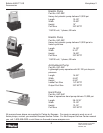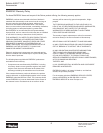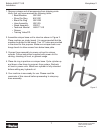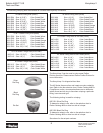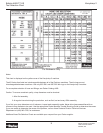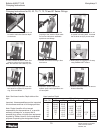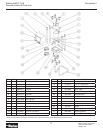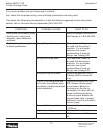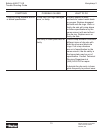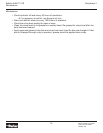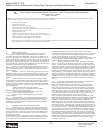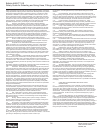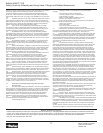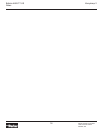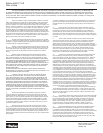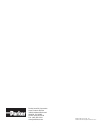
Bulletin 4480-T7-US Karrykrimp 2
Parker Hannifin Corporation
Hose Products Division
Wickliffe, OH
16
Parker manufacturers special Hose for aerospace in flight applications. Aerospace
in flight applications employing Hose to transmit fuel, lubricating fluids and hydraulic
fluids require a special Hose with a conductive inner tube. This Hose for in flight
applications is available only from Parker’s Stratoflex Products Division. Do not
use any other Parker Hose for in flight applications, even if electrically conductive.
Use of other Hoses for in flight applications or failure to properly connect or ground
this Hose can cause a fire or an explosion resulting in death, personal injury , and
property damage. These Hose assemblies for in flight applications must meet all
applicable aerospace industry, aircraft engine, and aircraft requirements.
2.2 Pressure: Hose selection must be made so that the published
maximum recommended working pressure of the Hose is equal to or greater than
the maximum system pressure. Surge pressures or peak transient pressures in
the system must be below the published maximum working pressure for the Hose.
Surge pressures and peak pressures can usually only be determined by sensitive
electrical instrumentation that measures and indicates pressures at millisecond
intervals. Mechanical pressure gauges indicate only average pressures and cannot
be used to determine surge pressures or peak transient pressures. Published
burst pressure ratings for Hose is for manufacturing test purposes only and is no
indication that the Product can be used in applications at the burst pressure or
otherwise above the published maximum recommended working pressure.
2.3 Suction: Hoses used for suction applications must be selected to insure
that the Hose will withstand the vacuum and pressure of the system. Improperly
selected Hose may collapse in suction application.
2.4 Temperature: Be certain that fluid and ambient temperatures, both
steady and transient, do not exceed the limitations of the Hose. Temperatures
below and above the recommended limit can degrade Hose to a point where
a failure may occur and release fluid. Properly insulate and protect the Hose
Assembly when routing near hot objects (e.g. manifolds). Do not use any Hose
in any application where failure of the Hose could result in the conveyed fluids (or
vapors or mist from the conveyed fluids) contacting any open flame, molten metal,
or other potential fire ignition source that could cause burning or explosion of the
conveyed fluids or vapors.
2.5 Fluid Compatibility: Hose Assembly selection must assure compatibility
of the Hose tube, cover, reinforcement, and Fittings with the fluid media used.
See the fluid compatibility chart in the Parker publication for the product being
considered or used. This information is offered only as a guide. Actual service life
can only be determined by the end user by testing under all extreme conditions and
other analysis.
Hose that is chemically compatible with a particular fluid must be assembled using
Fittings and adapters containing likewise compatible seals.
2.6 Permeation: Permeation (that is, seepage through the Hose) will occur
from inside the Hose to outside when Hose is used with gases, liquid and gas fuels,
and refrigerants (including but not limited to such materials as helium, diesel fuel,
gasoline, natural gas, or LPG). This permeation may result in high concentrations
of vapors which are potentially flammable, explosive, or toxic, and in loss of fluid.
Dangerous explosions, fires, and other hazards can result when using the wrong
Hose for such applications. The system designer must take into account the fact
that this permeation will take place and must not use Hose if this permeation could
be hazardous. The system designer must take into account all legal, government,
insurance, or any other special regulations which govern the use of fuels and
refrigerants. Never use a Hose even though the fluid compatibility is acceptable
without considering the potential hazardous effects that can result from permeation
through the Hose Assembly.
Permeation of moisture from outside the Hose to inside the Hose will also occur
in Hose assemblies, regardless of internal pressure. If this moisture permeation
would have detrimental effects (particularly, but not limited to refrigeration and air
conditioning systems), incorporation of sufficient drying capacity in the system or
other appropriate system safeguards should be selected and used.
2.7 Size: Transmission of power by means of pressurized fluid varies
with pressure and rate of flow. The size of the components must be adequate to
keep pressure losses to a minimum and avoid damage due to heat generation or
excessive fluid velocity.
2.8 Routing: Attention must be given to optimum routing to minimize
inherent problems (kinking or flow restriction due to Hose collapse, twisting of the
Hose, proximity to hot objects or heat sources).
2.9 Environment: Care must be taken to insure that the Hose and Fittings
are either compatible with or protected from the environment (that is, surrounding
conditions) to which they are exposed. Environmental conditions including but not
limited to ultraviolet radiation, sunlight, heat, ozone, moisture, water, salt water,
chemicals, and air pollutants can cause degradation and premature failure.
2.10 Mechanical Loads: External forces can significantly reduce Hose life
or cause failure. Mechanical loads which must be considered include excessive
flexing, twist, kinking, tensile or side loads, bend radius, and vibration. Use of swivel
type Fittings or adapters may be required to insure no twist is put
into the Hose. Unusual applications may require special testing prior to Hose
selection.
2.11 Physical Damage: Care must be taken to protect Hose from wear,
snagging, kinking, bending smaller that minimum bend radius, and cutting, any of
which can cause premature Hose failure. Any Hose that has been kinked or bent to
a radius smaller than the minimum bend radius, and any Hose that has been cut or
is cracked or is otherwise damaged, should be removed and discarded.
2.12 Proper End Fitting: See instructions 3.2 through 3.5. These
recommendations may be substantiated by testing to industry standards such as
SAE J517 for hydraulic applications, or MIL-A-5070, AS1339, or AS3517 for Hoses
from Parker’s Stratoflex Products Division for aerospace applications.
2.13 Length: When establishing a proper Hose length, motion absorption,
Hose length changes due to pressure, and Hose and machine tolerances and
movement must be considered.
2.14 Specifications and Standards: When selecting Hose and Fittings,
government, industry, and Parker specifications and recommendations must be
reviewed and followed as applicable.
2.15 Hose Cleanliness: Hose components may vary in cleanliness levels.
Care must be taken to insure that the Hose Assembly selected has an adequate
level of cleanliness for the application.
2.16 Fire Resistant Fluids: Some fire resistant fluids that are to be conveyed
by Hose require use of the same type of Hose as used with petroleum base fluids.
Some such fluids require a special Hose, while a few fluids will not work with any
Hose at all. See instructions 2.5 and 1.5. The wrong Hose may fail after a very
short service. In addition, all liquids but pure water may burn fiercely under certain
conditions, and even pure water leakage may be hazardous.
2.17 Radiant Heat: Hose can be heated to destruction without contact by
such nearby items as hot manifolds or molten metal. The same heat source may
then initiate a fire. This can occur despite the presence of cool air around the Hose.
2.18 Welding or Brazing: When using a torch or arc-welder in close
proximity to hydraulic lines, the hydraulic lines should be removed or shielded with
appropriate fire resistant materials. Flame or weld spatter could burn through the
Hose and possibly ignite escaping fluid resulting in a catastrophic failure. Heating
of plated parts, including Hose Fittings and adapters, above 450°F (232°C) such as
during welding, brazing, or soldering may emit deadly gases.
2.19 Atomic Radiation: Atomic radiation affects all materials used in Hose
assemblies. Since the long-term effects may be unknown, do not expose Hose
assemblies to atomic radiation.
2.20 Aerospace Applications: The only Hose and Fittings that may be used
for in flight aerospace applications are tHose available from Parker’s Stratoflex
Products Division. Do not use any other Hose or Fittings for in flight applications.
Do not use any Hose or Fittings from Parker’s Stratoflex Products Division with
any other Hose or Fittings, unless expressly approved in writing by the engineering
manager or chief engineer of Stratoflex Products Division and verified by the user’s
own testing and inspection to aerospace industry standards.
2.21 Unlocking Couplings: Ball locking couplings or other couplings with
disconnect sleeves can unintentionally disconnect if they are dragged over
obstructions or if the sleeve is bumped or moved enough to cause disconnect.
Threaded couplings should be considered where there is a potential for accidential
uncoupling.
3.0 HOSE AND FITTING ASSEMBLY AND INSTALLATION
INSTRUCTIONS
3.1 Component Inspection: Prior to assembly, a careful examination of
the Hose and Fittings must be performed. All components must be checked for
correct style, size, catalog number, and length. The Hose must be examined for
cleanliness, obstructions, blisters, cover looseness, kinks, cracks, cuts or any other
visible defects. Inspect the Fitting and sealing surfaces for burrs, nicks, corrosion
or other imperfections. Do NOT use any component that displays any signs of
nonconformance.
3.2 Hose and Fitting Assembly: Do not assemble a Parker Fitting on a
Parker Hose that is not specifically listed by Parker for that Fitting, unless authorized
in writing by the engineering manager or chief engineer of the appropriate Parker
division. Do not assemble a Parker Fitting on another manufacturers Hose or a
Parker Hose on another manufacturers Fitting unless (i) the engineering manager or
chief engineer of the appropriate Parker division approves the Assembly in writing
or that combination is expressly approved in the appropriate Parker literature for the
specific Parker product, and (ii) the user verifies the Assembly and the application
through analysis and testing. For Parker Hose
Safety Guide for Selecting and Using Hose, Fittings and Related Accessories



